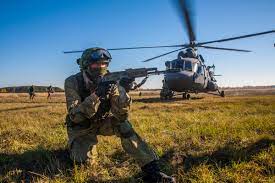
Social media platforms have recently been flooded with images that depict an unusual military combination. A supporter of Russia on Telegram has disseminated photos of a Soviet MT-LB, which is presently serving in the Russian army in Ukraine, outfitted with a 24 mm naval gun.
The Military Informant reports that this unique weapon configuration has been spotted in the war-torn areas around Avdiivka. The MT-LB is believed to be operated by Russian military volunteers from the 60th Separate Sabotage and Assault Brigade [SSAB], also known as the “Veterans”.
Upon initial inspection, it appears that the likely Soviet naval system installed on the MT-LB could be the 25 mm/79 [1″] 2M-3. However, according to the Telegram user, it might also be a 2M-3M modification.
The 2M-3 artillery pieces were originally supplied with 65-round cartridges, and early models could be loaded using 7-round clips. These were initially mounted on a structure referred to as a 2M-3. This base was later upgraded to the 2M-3M version. This modification, which incorporated gas operation, improved the automatic firing capabilities of these weapons, increasing their firing rate to between 470 and 480 rounds per minute during testing.
While these guns are primarily air-cooled, the cooling process is aided by a unique water-cooling system used during reloading. This involves the use of a custom hose for approximately 15 seconds.
Historically, these guns are based on the 84-KM, designed in 1943-44. Plans for a next-generation artillery piece were made in 1945 and revisited in 1947. Official trials for these guns began in 1949, and by 1953 they were formally added to the Soviet arsenal as the 110-PM. Production in the Soviet Union continued until 1984.
Interestingly, a North Korean version of this artillery, known as the Type 61, also exists.
The 60th Brigade Veterans, a volunteer unit that began its combat operations in Ukraine’s Northern Military District in 2022, is a relatively recent addition. Notably, the backbone of this brigade consists of members from renowned units in Donbas, such as “Oplot” and “Pyatnashka.” The term SSAB “Veterans” refers to the Separate Sabotage Assault Brigade, which originated from a battalion bearing the same name.
It’s crucial to note that the legal status of the “Veterans” falls somewhere between the Wagner PMC and a standard separate motorized rifle brigade from the Russian Ministry of Defense. According to the contract, a volunteer from the 60th Airborne Brigade “Veterans” receives a starting salary of 240 thousand rubles [$2,720], with no limit on bonuses.
The “Veterans” unit is looking for male volunteers aged between 20 and 55, including those without any previous combat experience. The desired specialties range from riflemen, grenade launchers, attack aircraft (interestingly, this type of training unit is not present in the Ministry of Defense), snipers, sappers, gunners, drivers, artillerymen, orderlies, paramedics, to signalmen. Having combat experience is considered an advantage.
New recruits undergo an initial two-week training period at the training ground, after which their readiness level is assessed. If found lacking, additional training time is provided. In the unfortunate event of a volunteer’s death on the front lines, the state guarantees full compensation to the family, similar to regular contract soldiers in the RF Armed Forces.
It’s worth remembering that the 60th Airborne Brigade follows the same military chain of command as the Wagner PMC or the GRU army special forces. A fighter can rise to the position of a squad commander based on their military experience, resourcefulness, and bravery.




